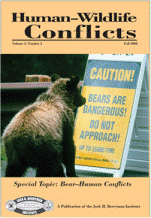Center, Internet, Wildlife Damage Management

Human–Wildlife Interactions
Date of this Version
Spring 2009
Document Type
Article
Abstract
Conflicts between elk (Cervus elaphus) and farmers have been occurring since the 1880s when agriculture began around what is now Riding Mountain National Park (RMNP). Initially, the conflicts were related to low elk numbers caused primarily by unregulated harvest of elk. The creation of RMNP in 1930 and the associated ban on hunting allowed elk numbers to reach critically high levels. Since farming began, elk have been associated with considerable damage to fences and crops around RMNP, with annual damage often >$240,000. Hunting on agricultural lands has been the most common approach to mitigating elk impacts, despite its limited success. Additionally, a damage compensation program was created in 1997. Beginning in 1991, elk–agriculture conflicts accelerated to a new level with the detection of bovine tuberculosis (TB) in local elk. Despite the concerns and economic hardship caused by TB, attitudes toward elk remain largely positive, and farmers obtain important economic and noneconomic benefits from the elk population. Conflicts between farmers and government about elk management often have been characterized by heated debates, poor or nonexistent communication, and, until recently, limited attempts to mitigate the impacts of elk. Future programs to address these conflicts should focus on collaboration and communication to develop mutually acceptable long-term solutions that are regularly evaluated using both local knowledge and scientific study.


Comments
Published in Human–Wildlife Conflicts 3(1):72–87, Spring 2009. Published and copyright by Jack H. Berryman Institute http://www.berrymaninstitute.org/journal/index.html